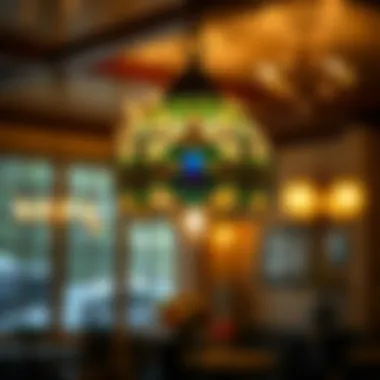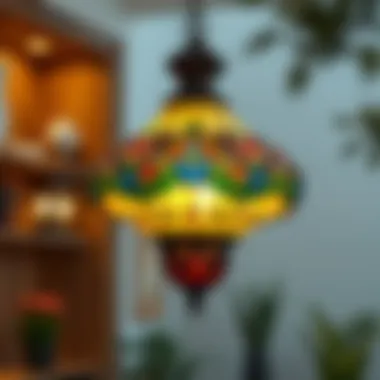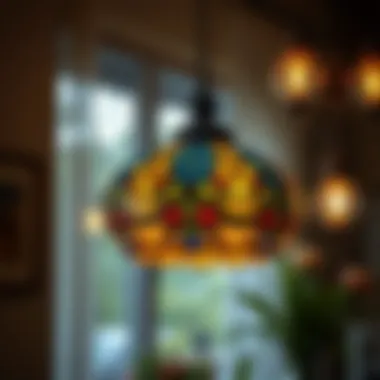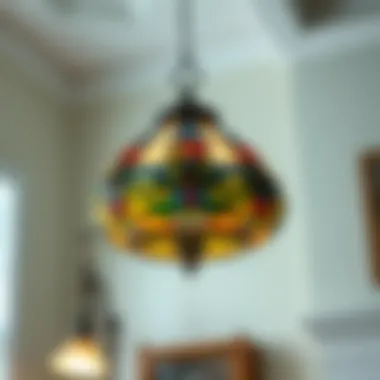A Comprehensive Guide to Tiffany Hanging Lamps


Intro
Tiffany hanging lamp plug-ins hold a significant place in the realm of interior design. With their colorful glass and intricate designs, they stand as a bridge between function and art. For homeowners and design enthusiasts, understanding these unique light fixtures can enhance both aesthetic appeal and ambient lighting in various spaces.
This guide aims to delve deep into the intricacies of Tiffany lamps. By exploring their design history, installation considerations, and practical applications, readers will gain insight into integrating these stunning pieces into their homes. Whether you want to spruce up a corner or illuminate a workspace, Tiffany lamps have a versatile charm that can complement various styles.
As we travel through the sections, we will touch on furniture styles, trends in material choices, and tips for care and maintenance. Each aspect is critical, whether you are a retailer aiming to expand your offerings or a DIY enthusiast contemplating your next project. By the end, you’ll be equipped with a wealth of information to thoughtfully enhance your living environment with the exquisite beauty of Tiffany hanging lamp plug-ins.
Prologue to Tiffany Hanging Lamp Plug-Ins
The attraction of Tiffany hanging lamp plug-ins is hard to overlook, especially for those who appreciate the fine details of interior design. These lamps not only illuminate spaces but also serve as artistic statements, embodying a blend of history and craftsmanship. By incorporating a variety of colors and patterns, Tiffany lamps can transform even the simplest of rooms into a vibrant tapestry of light and form.
When discussing Tiffany hanging lamps, it’s essential to understand their unique mechanics. The plug-in format allows these masterpieces to be easily situated anywhere, often without the need for complex installation. Homeowners can place them where they are most effective, whether that's a cozy reading nook or as a standout piece atop a console table. This flexibility is a significant advantage over traditional hardwired options, offering an easy solution for those who love to update their decor.
In addition to their aesthetic value, Tiffany plug-in lamps exemplify practicality. Many people prefer plug-ins as they avoid the hassle of electrical work, making them a popular choice for renters and those hesitant about major renovations. With the ability to move them around, these lamps can adapt as interior trends evolve, fitting seamlessly into both new renovations and classic setups.
The significance of Tiffany hanging lamp plug-ins goes beyond mere aesthetics and utility; they are steeped in a rich narrative of design evolution. Each lamp holds stories of artisanship and innovation, marking the shifting landscape of lighting solutions over the years. This article will explore these nuances, offering insights into the timeless allure of these remarkable fixtures.
Understanding the Mechanics of Plug-In Lamps
The significance of comprehending the mechanics behind plug-in lamps cannot be overstated, especially when it comes to Tiffany hanging lamps. These fixtures combine artistry with practicality, making it essential to know how they work regarding both functionality and aesthetic appeal. A proper understanding not only enhances the experience of having such lamps in your space but also aids in their safe installation and efficient use. This section will delve into the various components, wiring, benefits, and considerations that come into play with plug-in lamps, specifically aiming to enlighten homeowners, designers, retailers, and DIY enthusiasts alike.
Components of a Plug-In Lamp
To really grasp the mechanics of plug-in lamps, one needs to familiarize themselves with their essential components. Most plug-in lamps are assembled using the following:
- Lamp Base: The foundation that holds the lightbulb socket in place. They come in various shapes and materials, often crafted to complement the lamp's overall design.
- Lightbulb Socket: This is where the bulb sits, connecting it to the electrical circuit. Standard sizes include E26 (medium base) or E12 (candelabra base), depending on the lamp’s design.
- Cord: Vital for connecting to an electrical outlet, cords can vary in length and thickness. Many Tiffany lamps utilize fabric-wrapped cords that not only offer durability but also enhance aesthetic quality.
- Plug: Typically, a polarized plug, which plugs directly into the wall socket, ensuring a secure connection.
- Shade: While primarily for style, the shade also contributes to the lamp's light diffusion, critical for creating the desired ambiance.
These components work in unison to create a lamp that is both functional and pleasing to the eye, harmonizing with any decor.
Wiring and Electrical Considerations
Wiring is crucial when discussing plug-in lamps. Although plug-in design offers convenience, ensuring that all electrical aspects are correctly handled is vital for safety. Here are a few critical points to consider:
- Electrical Safety: Always use bulbs rated for the watts specified for your lamp. Exceeding this can lead to overheating, posing a fire hazard.
- Grounding: Although most plugs are polarized, ensuring that your lamp is grounded can further enhance safety. This is especially true if the lamp is placed in areas prone to moisture.
- Cords: Inspect cords for damage and wear regularly. A frayed or damaged cord can create shock hazards or lead to malfunction.
- Distance from Water Sources: Keep lamps away from sinks or wet areas where water might come into contact with outlets or cords.
By paying attention to these details, one can enjoy the beauty of their Tiffany lamp without compromising on safety.
Benefits of Plug-In Versus Hardwired Options
When choosing between plug-in and hardwired lamps, both options have unique advantages and considerations. Here’s a comparison that outlines the benefits of opting for plug-in lamps:
- Easy Installation: Plug-in lamps don’t require any installation work. One can simply unpack and place them wherever needed, allowing for tremendous flexibility in arrangement.
- Portability: If you’re fond of rearranging your space, plug-in lamps make it easy to switch things up without the hassle of rewiring.
- Less Commitment: With plug-ins, there’s no long-term commitment required — if your taste changes, so can your lamp placement without needing to call an electrician.
- Cost-Effective: Often, plug-in lamps are more affordable, both in initial investment and installation costs when compared to hardwired options.
- Diverse Design Choices: Plug-in lamps can be found in countless designs, so you’re likely to find a Tiffany lamp that aligns perfectly with your decor.


In summary, understanding the mechanics of plug-in lamps can significantly enhance the enjoyment and utility of your Tiffany hanging lamp. Knowledge about its components, wiring, and the benefits these lamps offer can help you make informed decisions for your home.
Design Aesthetics and Variations
When considering Tiffany hanging lamp plug-ins, the design aesthetics and variations play a pivotal role in how these lamps can enhance or transform a space. It’s not merely about providing illumination; it’s about how each piece can serve as an artistic statement while harmonizing with existing decor.
Tiffany lamps are deeply rooted in the artistic expressions of their time, embodying the beauty and craftsmanship of stained glass. As such, understanding these designs allows homeowners and designers alike to make informed choices that reflect both personal style and the functional requirements of modern living.
Classic Tiffany Styles
Classic Tiffany lamps are synonymous with elegance and artisanal quality. Each lamp tells a story, often drawing inspiration from nature, featuring motifs like floral patterns, dragonflies, or geometric shapes. The iconic leaded glass composition allows light to filter through in a way that shifts with the hour and angle, creating a play of colors and shadows that can enliven any room.
These timeless designs not only pay homage to the craftsmanship of the early 20th century but also evoke a sense of nostalgia. Homeowners often favor classic lamps for settings that aspire for sophistication, such as libraries, studies, or formal dining rooms. Key features include:
- Intricate glasswork: Handcrafted glass pieces meld together, ensuring every lamp is unique.
- Muted color palettes: Rich jewel tones coupled with soft neutrals accommodate various design schemes without overpowering the surrounding decor.
Incorporating a classic Tiffany lamp can serve as a focal point, leading visitors to appreciate the intricate details and artistry that define the lamp's legacy.
Modern Interpretations of Tiffany Designs
As decor trends have evolved, so too have interpretations of Tiffany designs. Modern versions often blend traditional craftsmanship with contemporary aesthetics. Homeowners might find sleek, minimalistic designs that maintain the essence of Tiffany style but are tailored for today's sensibilities.
For instance, some designers experiment with streamlined forms that incorporate LED technology for efficiency while retaining the liberty of color synonymous with Tiffany’s glasswork. This allows a blend of art and function, catering to a modern lifestyle that demands sustainability and energy-efficiency. Considerations in this realm include:
- Sleek lines: Modern lamps often feature softer silhouettes that can fit seamlessly into open-concept spaces.
- Diverse materials: From metal bases to frosted glass, contemporary interpretations integrate various materials, allowing for greater versatility in design.
The beauty of these adaptations is that they invite a broader audience to appreciate Tiffany’s legacy while making it relevant in a fast-paced, contemporary world.
Color Schemes and Glass Variations
Color plays an integral role in the allure of Tiffany lamps. Each piece is celebrated not just for its form but for how the colors dance with light and shadow. Traditional Tiffany lamps often feature a palette of greens, blues, and rich reds, reminiscent of a lush garden or a vibrant sunset. Being able to leverage color schemes enhances interior design, as it affects mood and enhances spatial perception.
When exploring color schemes, consider:
- Cohesion with existing decor: It’s crucial to match or complement the colors found in upholstery and wall art.
- Mood enhancement: Cool tones can promote calmness, while warm tones can invigorate a space; choose accordingly to evoke your desired atmosphere.
Each glass variation not only stands out individually but also influences the surrounding decor. Whether opting for an orange and yellow butterfly design or a subtle blue and green geometric composition, blending these color schemes into a room can create a lovely aura that reflects character and warmth.
In sum, embracing the various design aesthetics and styles of Tiffany hanging lamps offers a vast playground for creativity. It allows for personal expression while ensuring that these beautiful artifacts find relevance in today’s design landscape.
Placement and Usage in Interior Design
When it comes to enhancing the charm and functionality of a space, the placement and usage of Tiffany hanging lamp plug-ins can't be overlooked. A well-placed lamp not only illuminates a room but also serves as a striking centerpiece that pulls together various design elements. This section delves into the thoughtful considerations and benefits of strategically integrating these lamps into modern interior settings.
Strategic Placement for Aesthetic Impact


Positioning a Tiffany lamp is akin to choosing the right piece of jewelry for an outfit; it should enhance the overall appearance of the room. One pivotal aspect to consider is the height at which the light hangs. A lamp that’s too high may fail to cast its beautiful glow, while one that hangs too low can obstruct views or create discomfort. In open areas, such as living rooms or dining spaces, aim for a balance that allows the stained glass shades to catch the eye, offering a view of the intricate designs without overwhelming the space.
Placement near corners can also be particularly effective. Corners, often overlooked, can truly benefit from a touch of light. Not only does it brighten usually darker zones, but it also creates a cozy nook perfect for reading or relaxing. For instance, a Tiffany lamp beside a plush armchair can transform a simple corner into a reading haven.
Additionally, don't shy away from using multiple lamps in one room. This layering can create depth and warmth throughout a larger space. Consider using one pendant lamp above a dining table, accompanied by smaller side lamps strategically placed on consoles or side tables. The interplay of light from different sources can amplify the overall ambiance and make the space inviting.
Integrating with Existing Decor Styles
Examining the decor within a room can help determine how a Tiffany lamp will fit in. For instance, in a room filled with antique furniture, a traditional Tiffany lamp can enhance the historical context. On the other hand, it can add a retro flair if paired with minimalist or industrial decor.
Understanding color palettes is essential too. The stunning glasswork of Tiffany lamps often showcases a color spectrum that varies significantly from one piece to another. Thus, the integration should be meticulously planned. Pair a lamp with softer tones alongside muted decor to allow it to pop without overwhelming the senses. Conversely, rich, bold hued lamps can stand out dramatically in spaces that have a neutral or monochromatic color scheme.
Lighting Effects and Mood Enhancement
How we light a space can significantly affect the mood it evokes. Tiffany lamps are known for their ability to cast a warm, amber-hued light, often creating a cozy atmosphere that invites relaxation. This quality makes them ideal for spaces dedicated to leisure, like living rooms, bedrooms, or reading nooks.
Moreover, the unique patterns created by the stained glass can project an intricate display of colors and shapes on surrounding surfaces. For example, a lamp placed near a textured wall can create dynamic shadows that enhance the ambiance. Consider adjusting your lamp position throughout the day to observe how the changing natural light interacts with the lamp’s glow.
Additionally, the adjustable brightness of modern plug-in lamps makes it feasible to curtail the intensity of the light, helping create different moods for varied occasions—be it a family gathering or an intimate dinner.
"Proper placement of lighting fixtures can elevate a space from ordinary to extraordinary, transforming merely functional areas into experiences."
In summary, employing Tiffany hanging lamp plug-ins effectively requires a careful approach to placement, an eye for integrating with existing decor, and a keen understanding of how light affects atmosphere. By considering these aspects, homeowners can thoughtfully enhance their living spaces while preserving the timeless charm of Tiffany lamps.
Installation and Maintenance Guidelines
When it comes to integrating Tiffany hanging lamp plug-ins into your space, understanding the installation and maintenance processes is key. These guidelines not only enhance the lamp's functionality but also ensure safety while preserving the exquisite design of the lamps. Neglecting these aspects may lead to a diminished experience of the elegant lighting that Tiffany lamps promise.
Step-by-Step Installation Process
Installing a Tiffany lamp plugin is not rocket science; however, it does require a bit of know-how and care. A systematic approach can save headaches down the line. Here's a step-by-step process to guide you through the installation:
- Choose the Right Location: Identify a suitable spot that allows the lamp to shine fully. Consider factors like wall color, room decor, and availability of electrical outlets.
- Unbox and Inspect: Carefully open the package and inspect for any damages. Notify the retailer if anything looks amiss.
- Gather Tools: Have your necessary tools at hand. Generally, all you’ll need is a screwdriver.
- Assemble the Lamp: Follow the manufacturer's instructions to assemble any parts that might be disassembled for shipping. Most Tiffany lamps come with clear, visual guides.
- Plugging It In: Plug the lamp into a nearby outlet. Ensure that the cord runs neatly along the wall or furniture, avoiding trip hazards.
- Testing: Before setting it fully in place, switch it on to make sure everything operates smoothly. If it lights up flawlessly, you’re good to go.
- Final Placement: Once confirmed, secure the lamp in its designated location.
This simple, step-by-step process can help you avoid any installation mishaps while making sure that the lamp shines bright and provides the ambiance you desire.
Routine Maintenance Practices
Even the most stunning Tiffany lamps need a little TLC to keep them looking sharp. Routine maintenance not only keeps them aesthetically pleasing but also prolongs their life. Here are some practices to consider:
- Dust Regularly: Use a microfiber cloth to gently wipe off dust. Avoid abrasive materials that can scratch the glass.
- Check the Bulb: Ensure that the bulb is functioning optimally. Replace it if you notice it flickering. It's advisable to use a soft white bulb to best illuminate the colors in the Tiffany glass.
- Inspect the Electrical Components: Look at the plug and cord periodically for any signs of wear or damage. This ensures safety and functionality. If you see frays or defects, replace them immediately.
- Store Correctly if Necessary: If you ever need to store the lamp, wrap it in a soft, cushioned cloth to protect the glass from scratches and chips.
By adhering to these simple practices, one can enhance both safety and aesthetic appeal.


Common Issues and Troubleshooting
Just like any other fixture, Tiffany lamps can sometimes present challenges. Here's a concise look into common issues and how to troubleshoot them:
- Lamp Doesn’t Turn On: First, check if it’s properly plugged in. If the plug looks fine, try a different outlet. If it still doesn't work, it may be time to replace the bulb.
- Flickering: A wobbly bulb might cause flickering. Tighten it, and if it still flickers, there could be a wiring issue that needs attention.
- Dimming Over Time: Over time, bulbs can dim as they near the end of life. Replace the bulb and see if this resolves the issue.
- Broken Glass: If the glass is damaged, assess whether it is a simple crack or a significant break. For the latter, consult a professional for repairs.
“Routine maintenance is just like a good health check-up for your home decor.”
In summary, knowing how to install and maintain Tiffany hanging lamp plug-ins enhances their beauty, ensures safety, and allows you to enjoy their elegance for many years to come. By following these guidelines, homeowners, designers, and DIY enthusiasts alike can effectively incorporate these exquisite fixtures into their decor.
The Future of Tiffany Lighting
As we peer into the horizon of interior design and lighting, the future of Tiffany lamps looms larger than ever. With their storied history and intricate craftsmanship, the Tiffany lamps are not merely relics of the past; they are evolving pieces that continue to find relevance in modern homes. Understanding the trajectory of these lamps helps us appreciate their timeless beauty while also recognizing the shifts in consumer preferences and environmental considerations.
Emerging Trends in Lighting Design
The lighting design market is shifting rapidly, and Tiffany lamps are not being left behind. New trends point towards a combination of contemporary ingenuity and classic design. Here are some trends making waves in the realm of lighting:
- Smart Lighting Integration: Today’s homeowners are tech-savvy. Plug-in Tiffany lamps are increasingly being designed to embrace smart technology, enabling voice control and automation. Imagine dimming the lights with just a shout or creating a serene ambience through an app!
- Mixing Styles: While traditional elegance will always have its place, more designers are opting to mix architectural styles. This means that a vibrant Tiffany lamp can sit comfortably amongst industrial settings or minimalistic designs, breathing new life into otherwise stark environments.
- Customization: Tailoring Tiffany lamps according to individual tastes is becoming popular. Homeowners want to ensure that their lamps mirror their unique styles. Custom color options, sizes, and even patterns allow for a personal touch that resonates deeply with consumers.
These trends highlight how the Tiffany lamp is adapting while retaining the elements lovers of the style hold dear.
Sustainability in Lamp Production
With the growing emphasis on sustainability, lamp manufacturers are grappling with the challenge of minimizing their environmental footprint. Tiffany lamp production is also feeling this push, as consumers are more aware of the materials and processes involved in the items they purchase. Important considerations include:
- Materials Sourcing: Eco-friendly materials are becoming a focal point. Suppliers are increasingly turning to responsibly sourced glass and recycled metals, ensuring that the end product has a less detrimental impact on the planet compared to traditional methods.
- Energy-Efficient Technology: Incorporating LED technology into Tiffany lamp production is a win-win. Not only does it enhance the lifespan of the lamps, but it also reduces energy consumption, appealing to eco-conscious homeowners looking for sustainable lighting solutions.
- Ethical Manufacturing Practices: More companies are striving to follow ethical practices in production. Transparency around labor conditions and environmental regulations is increasingly demanded by consumers who prioritize responsible buying.
Overall, the push for sustainability is a driving factor in redefining how Tiffany lamps are made and integrated into homes.
"The beauty of Tiffany lamps lies not only in their dazzling glasswork but also in their ability to adapt, honor tradition, and prioritize the planet moving forward."
In summary, the future of Tiffany lighting paints an optimistic picture. The blend of technology, the commitment to sustainability, and the appreciation for timeless artistry ensure that these cherished icons will continue to charm and enhance living spaces for years to come.
Ending
In wrapping up the exploration of Tiffany hanging lamp plug-ins, it becomes clear that these fixtures are more than just sources of light; they encapsulate an art form that has thrived through generations. The timeless charm of Tiffany lamps transcends mere aesthetics; they serve as conversation starters, nostalgic pieces, and functional art, creating atmospheres that resonate warmth and creativity in any space.
Reflecting on the Timeless Charm of Tiffany Lamps
At their core, Tiffany lamps symbolize a marriage of functionality and artistry. Built with an unmatched attention to detail, the glass shades catch the light in a way that transforms the mundane into the magical. Their distinctive patterns and colors not only elevate the decor but also reflect the changing tastes and styles of different eras. This blend of history and innovation is what makes Tiffany lamps timeless.
The intricate craftsmanship involved in each piece promotes a sense of individuality that mass-produced items lack. When one experiences a Tiffany lamp, it’s evident that each one has its own story, one that intertwines with the lives of those who use it. Consider these points:
- Unique Designs: Each lamp showcases a unique arrangement of stained glass, often drawing inspiration from nature and geometric patterns.
- Versatility: Tiffany plug-ins can complement various decor styles, from modern sleekness to rustic charm, without losing their identity.
- Emotional Connection: The warmth radiating from these lamps often evokes a sense of nostalgia, reminding us of intimate gatherings or quiet evenings of reflection.
In the bigger picture, Tiffany lamps remind us of the importance of integrating both beauty and purpose in our living spaces. As you consider enhancing your own home environment, reflect on how Tiffany plug-ins can not only illuminate the room but also serve as a centerpiece that intrigues and inspires.
"Art is not what you see, but what you make others see." – Edgar Degas
The journey of examining Tiffany lamps reveals their significance not only in lighting but also in the broader conversation about style, history, and personal expression in home decor.















